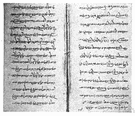Avesta
(redirected from Avestas)Also found in: Thesaurus, Encyclopedia.
Related to Avestas: Zoroaster
A·ves·ta
(ə-vĕs′tə)n.
The body of sacred writings of the Zoroastrian religion.
[Short for Zend-Avesta.]
American Heritage® Dictionary of the English Language, Fifth Edition. Copyright © 2016 by Houghton Mifflin Harcourt Publishing Company. Published by Houghton Mifflin Harcourt Publishing Company. All rights reserved.
Avesta
(əˈvɛstə)n
(Other Non-Christian Religious Writings) a collection of sacred writings of Zoroastrianism, including the Songs of Zoroaster
Collins English Dictionary – Complete and Unabridged, 12th Edition 2014 © HarperCollins Publishers 1991, 1994, 1998, 2000, 2003, 2006, 2007, 2009, 2011, 2014
A•ves•ta
(əˈvɛs tə)n.
a collection of sacred Zoroastrian writings.
Random House Kernerman Webster's College Dictionary, © 2010 K Dictionaries Ltd. Copyright 2005, 1997, 1991 by Random House, Inc. All rights reserved.
ThesaurusAntonymsRelated WordsSynonymsLegend:
Switch to new thesaurus
| Noun | 1. |  Avesta - a collection of Zoroastrian texts gathered during the 4th or 6th centuries Avesta - a collection of Zoroastrian texts gathered during the 4th or 6th centuries |
Based on WordNet 3.0, Farlex clipart collection. © 2003-2012 Princeton University, Farlex Inc.